
The cuisine of Mexico City encompasses a variety of cuisines. Restaurants specialize in the regional cuisines of Mexico's 31 states, and the city also has several branches of internationally recognized restaurants.

The cuisine of Mexico City encompasses a variety of cuisines. Restaurants specialize in the regional cuisines of Mexico's 31 states, and the city also has several branches of internationally recognized restaurants.
In 1325, the Aztecs settled in the region around Lake Texcoco in the highlands of Central Mexico. Here they lived off the rich food resources of the lake and developed sophisticated constructions of canals for irrigation, terracing, and 'sunken' gardens called chinampas to work the productive marsh lands around the lake. [1]
By the late 16th century, sweetened chocolate drinks spiced with nutmeg and cinnamon were very popular in Mexico City. As the colonial era drew to a close refined multi-court meals had become standard for the Mexico City aristocracy, beginning with a soup like albondigas, usually followed by a fried Spanish rice garnished with slices of hard boiled egg. The main dishes were numerous and consisted of stewed or roasted meats which could be mutton stew with chili, roast chicken stuffed with onion, or less commonly beef dishes. Meat courses were followed by frijoles refritos, and for dessert custard, sweet pastry or fresh fruits. [2]
19th century cookbooks rarely included recipes for corn-based dishes like atole, tamales, quesadillas or enchiladas, and those that did called them almuerzos ligeros (light brunches). The concept of a national cuisine was, in Mexico City, divided between the continental European style cuisine associated with Mexican elites and the typical commoner's fare. [3]

Once considered plebeian fare, by the 19th century, tacos had become a standard of Mexico City's cuisine. Workers moving to Mexico City from the rural countryside brought their culinary traditions with them. As unlicensed vendors began selling corn-based dishes on the street, authorities struggled to tax local taquerias, imposing licensing requirements and penalties, they recorded some details of the types of foods being served by these establishments. The most frequent reference was for tacos de barbacoa . Also mentioned are enchiladas, tacos de minero and gorditas , along with oyster shops and fried fish stands. There is evidence of some regional specialties being made available for the recent migrants; at least two shops were known to serve pozole , a type of stew similar to hominy that is a staple of Guadalajara, Jalisco. [4]
In the 1940s, the first meal of the day, called desayuno, would have been a light meal of a hot drink like coffee or hot chocolate, atole (corn porridge) and sweet bread or pastry, usually eaten around dawn. The second meal, almuerzo, eaten a few hours later was more substantial and included chilaquiles , eggs or meat. The hearty multi-course mid-day meal (comida) would have included a soup, rice, meat, vegetables and dessert. An early evening meal could include bread and coffee, and on special occasions a more substantial dinner might be served. Mole sauces were prepared for special feastdays. [1]
The commercial food industry expanded during World War II after the construction of the Pan-American Highway. Pre-sliced sandwich bread produced by commercial bakeries became a common household item, and beer began to overtake pulque as the most common beverage. Chicken became more widely available in the post-War era and processed meats like hams, sausages, and other cold cuts became available, aided by the arrival of European immigrants experienced in industrialized meat processing. Local butcher shops were stocked with cecina , chicharron and chorizo. Before this expansion of production and distribution, meat production had mostly taken place within the household. [1]

Barbacoa de borrego (a slow-cooked lamb dish) is one of the most popular traditional dishes. It is more commonly prepared in the suburban outskirts in the Mexico City environs, such as Texcoco, where there is a centuries-old barbacoa tradition. The technique of wrapping the lamb in maguey cactus leaves and cooking it overnight in an earthen oven is borrowed from traditional Maya cuisine. Families from Mexico City often travel, usually on Sundays, to eat the dish where it is made. It is common for loyal clientele to patronize the same establishments as their parents or grandparents. [5]
There were few roads in and out of Mexico City in the 1940s; the major food markets, La Merced and Mercado Jamaica were mostly supplied by canal. There were few restaurants and little local food production aside from a few staple goods like cooking oil, flour and cookies. Most foods were prepared at home using corn, squash, beans, chiles and other locally grown crops available from the markets, usually accompanied by pork or beef. [1]
Mexico City is known for having some of the freshest fish and seafood in Mexico's interior. La Nueva Viga Market is the second largest seafood market in the world after the Toyosu Market in Tokyo, Japan. [6]

Some of the dishes found in Mexico City's restaurants have pre-Conquest roots: lobster in red chile sauce, cactus fruit tortillas and tamales with greens in crab sauce, are based on historic dishes attested to in the 16th-century Florentine Codex. [4]
In the 1850s, fine dining establishments with views of Chapultepec Castle began catering to wealthy clientele. In 1891, at the behest of Ignacio de la Torre y Mier, Parisian chef Sylvain Daumont opened a restaurant in the city. Some menus have survived offering glimpses of the European-inspired cuisine served at the feasts, which featured no Mexican dishes. At Mexican president Porfirio Diaz's birthday celebration the wives of banquet guests watched from the balcony, as only men were seated for the meal. [3]
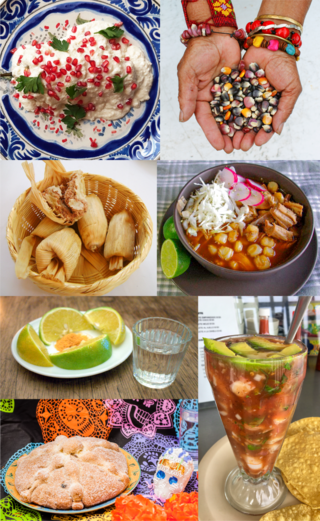
Mexican cuisine consists of the cooking cuisines and traditions of the modern country of Mexico. Its earliest roots lie in Mesoamerican cuisine. Its ingredients and methods begin with the first agricultural communities such as the Olmec and Maya who domesticated maize, created the standard process of nixtamalization, and established their foodways. Successive waves of other Mesoamerican groups brought with them their cooking methods. These included: the Teotihuacanos, Toltec, Huastec, Zapotec, Mixtec, Otomi, Purépecha, Totonac, Mazatec, Mazahua, and Nahua. With the Mexica formation of the multi-ethnic Triple Alliance, culinary foodways became infused.

An enchilada is a Mexican dish consisting of a corn tortilla rolled around a filling and covered with a savory sauce. Enchiladas can be filled with various ingredients, including meats, cheese, beans, potatoes, vegetables, or combinations. Enchilada sauces include chili-based sauces, such as salsa roja, various moles, tomatillo-based sauces, such as salsa verde, or cheese-based sauces, such as chile con queso.

In North America, a corn tortilla or just tortilla is a type of thin, unleavened flatbread, made from hominy, that is the whole kernels of maize treated with alkali to improve their nutrition in a process called nixtamalization. A simple dough made of ground, dried hominy, salt and water is then formed into flat discs and cooked on a very hot surface, generally an iron griddle called a comal.
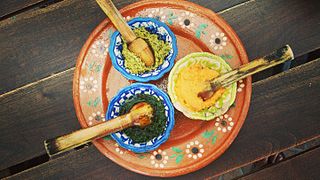
Salsa encompasses a variety of sauces used as condiments for tacos and other Mexican and Mexican-American foods, and as dips for tortilla chips. They may be raw or cooked, and are generally served at room temperature.

Latin American cuisine is the typical foods, beverages, and cooking styles common to many of the countries and cultures in Latin America. Latin America is a highly racially, ethnically, and geographically diverse with varying cuisines. Some items typical of Latin American cuisine include maize-based dishes arepas, empanadas, pupusas, tacos, tamales, tortillas and various salsas and other condiments. Sofrito, a culinary term that originally referred to a specific combination of sautéed or braised aromatics, exists in Latin American cuisine. It refers to a sauce of tomatoes, roasted bell peppers, garlic, onions and herbs. Rice, corn, pasta, bread, plantain, potato, yucca, and beans are also staples in Latin American cuisine.

The cuisine of the Southwestern United States is food styled after the rustic cooking of the Southwestern United States. It comprises a fusion of recipes for things that might have been eaten by Spanish colonial settlers, cowboys, Native Americans, and Mexicans throughout the post-Columbian era; there is, however, a great diversity in this kind of cuisine throughout the Southwestern states.
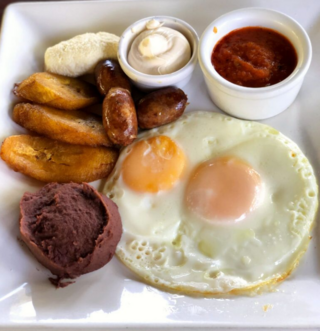
Salvadoran cuisine is a style of cooking derived from the nation of El Salvador. The indigenous foods consist of a mix of Amerindian cuisine from groups such as the Lenca, Pipil, Maya Poqomam, Maya Chʼortiʼ, Alaguilac and Cacaopera peoples. Many of the dishes are made with maize (corn). There is also heavy use of pork and seafood. European ingredients were incorporated after the Spanish conquest.

Chicharrón is a dish generally consisting of fried pork belly or fried pork rinds. Chicharrón may also be made from chicken, mutton, or beef.

New Mexican cuisine is the cuisine of the Southwestern US state of New Mexico. The region is primarily known for its fusion of Pueblo Native American cuisine with Hispano Spanish and Mexican cuisine originating in Nuevo México. This Southwestern culinary style is popular beyond the current boundaries of New Mexico, and is found throughout the old territories of Nuevo México and the New Mexico Territory, today the state of Arizona, parts of Texas, and the southern portions of Colorado, Utah, and Nevada.

The cuisine of the Democratic Republic of the Congo and the Republic of the Congo varies widely, representing the food of indigenous people. Cassava, fufu, rice, plantain and potatoes are generally the staple foods eaten with other side dishes.
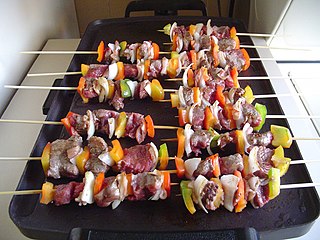
Honduran cuisine is a fusion of Mesoamerican, Spanish, Caribbean and African cuisines. There are also dishes from the Garifuna people. Coconut and coconut milk are featured in both sweet and savory dishes. Regional specialties include sopa de caracol, fried fish, tamales, carne asada and baleadas. Other popular dishes include meat roasted with chismol and carne asada, chicken with rice and corn, and fried fish with pickled onions and jalapeños. In the coastal areas and the Bay Islands, seafood and some meats are prepared in many ways, including with coconut milk. Among the soups the Hondurans enjoy are bean soup, mondongo soup, seafood soups and beef soups. Generally all of these soups are mixed with plantains, yuca, and cabbage, and served with corn tortillas.

Most traditional foods in Guatemalan cuisine are based on Maya cuisine, with Spanish influence, and prominently feature corn, chilies and beans as key ingredients. Guatemala is famously home to the Hass avocado.

Mexican street food, called antojitos, is prepared by street vendors and at small traditional markets in Mexico. Street foods include tacos, tamales, gorditas, quesadillas, empalmes, tostadas, chalupa, elote, tlayudas, cemita, pambazo, empanada, nachos, chilaquiles, fajita tortas, even hamburgers and hot dogs, as well as fresh fruits, vegetables, beverages and soups such as menudo, pozole and pancita. Most are available in the morning and the evening, as mid-afternoon is the time for the main formal meal of the day. Mexico has one of the most extensive street food cultures in Latin America, and Forbes named Mexico City as one of the foremost cities in the world in which to eat on the street.

Belizean cuisine is an amalgamation of all ethnicities in the nation of Belize and their respectively wide variety of foods. Breakfast often consists of sides of bread, flour tortillas, or fry jacks that are often homemade and eaten with various cheeses. All are often accompanied with refried beans, cheeses, and various forms of eggs, etc. Inclusive is also cereal along with milk, coffee, or tea.

Texas Barbecue refers to methods of preparation for barbecue unique to Texan cuisine. Beef brisket, pork ribs, and sausage are among the most commonly known dishes. The term can also include side dishes that are traditionally served alongside the smoked meats.
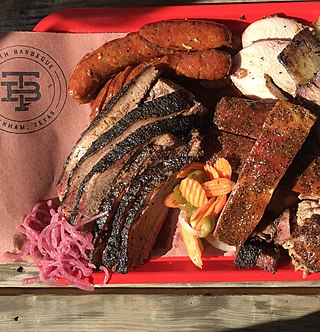
Texan cuisine is the food associated with the Southern U.S. state of Texas, including its native Southwestern cuisine influenced Tex-Mex foods. Texas is a large state, and its cuisine has been influenced by a wide range of cultures, including Tejano/Mexican, Native American, Creole/Cajun, African-American, German, Czech, Southern and other European American groups.

Oaxacan cuisine is a regional cuisine of Mexico, centered on the city of Oaxaca, the capital of the eponymous state located in southern Mexico. Oaxaca is one of Mexico's major gastronomic, historical, and gastro-historical centers whose cuisine is known internationally. Like the rest of Mexican cuisine, Oaxacan food is based on staples such as corn, beans and chile peppers, but there is a great variety of other ingredients and food preparations due to the influence of the state's varied geography and indigenous cultures. Corn and many beans were first cultivated in Oaxaca. Well known features of the cuisine include ingredients such as chocolate, Oaxaca cheese, mezcal and grasshoppers (chapulines) with dishes such as tlayudas, Oaxacan style tamales and seven notable varieties of mole sauce. The cuisine has been praised and promoted by food experts such as Diana Kennedy and Rick Bayless and is part of the state's appeal for tourists.
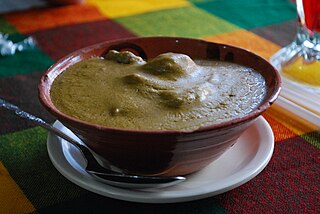
The cuisine of Chiapas is a style of cooking centered on the Mexican state of the same name. Like the cuisine of rest of the country, it is based on corn with a mix of indigenous and European influences. It distinguishes itself by retaining most of its indigenous heritage, including the use of the chipilín herb in tamales and soups, used nowhere else in Mexico. However, while it does use some chili peppers, including the very hot simojovel, it does not use it as much as other Mexican regional cuisines, preferring slightly sweet seasoning to its main dishes. Large regions of the state are suitable for grazing and the cuisine reflects this with meat, especially beef and the production of cheese. The most important dish is the tamal, with many varieties created through the state as well as dishes such as chanfaina, similar to menudo and sopa de pan. Although it has been promoted by the state of Chiapas for tourism purposes as well as some chefs, it is not as well known as other Mexican cuisine, such as that of neighboring Oaxaca.